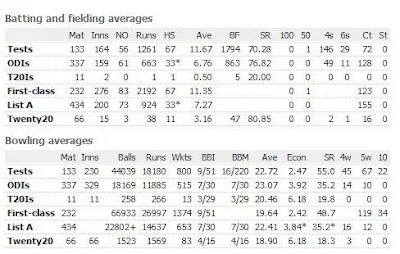 |
| Murali in action |
Muttiah Muralitharan, Sri Lankan cricketer, who was rated the greatest Test match bowler ever by Wisden Cricketers' Almanack in 2002. Muralitharan is the highest wicket-taker in both Test cricket and in One Day Internationals . He took the wicket of Gautam Gambhir on 5 February 2009 in Colombo to surpass Wasim Akram's ODI record of 502 wickets. Muralitharan became the highest wicket-taker in Test cricket when he overtook the previous record-holder Shane Warne on 3 December 2007. Muralitharan had previously held the record when he surpassed Courtney Walsh's 519 wickets in 2004, but he suffered a shoulder injury later that year and was then overtaken by Warne.
 |
| Profile of Muttiah Muralitharan courtesy cricinfo.com |
Averaging over six wickets per Test, Muralitharan was one of the most successful bowlers in the game. Muralitharan held the number one spot in the International Cricket Council’s player rankings for Test bowlers for a record period of 1,711 days spanning 214 Test matches.
 |
| Bowling action of Murali |
He plays domestic cricket for the Tamil Union Cricket and Athletic Club, and plays in the Indian Premier League for Chennai Super Kings.
 |
| Statistics of Muttiah Muralitharan courtesy cricinfo.com |
Muralitharan's career has been beset with controversy; his bowling action called into question on a number of occasions by umpires and sections of the cricket community. After biomechanical analysis under simulated playing conditions, Muralitharan's action was cleared by the International Cricket Council.
On 7 July 2010, Muttiah Muralitharan formally announced his retirement from Test cricket at a media briefing in Colombo. He confirmed that the first Test Match against India due to commence on 18 July, 2010 would be his last, but indicated that he was willing to play One-Day Internationals if it was considered necessary leading up to the 2011 World Cup, which Sri Lanka will co-host. He identified Sri Lanka's World Cup win of 1996 as his greatest moment as a cricketer. He also stated that there were some regrets during his 19 year playing career. "Not winning Test Matches in South Africa, Australia and India are regrets. But I am sure we will win very soon."
On 7 July 2010, Muttiah Muralitharan formally announced his retirement from Test cricket at a media briefing in Colombo. He confirmed that the first Test Match against India due to commence on 18 July, 2010 would be his last, but indicated that he was willing to play One-Day Internationals if it was considered necessary leading up to the 2011 World Cup, which Sri Lanka will co-host. He identified Sri Lanka's World Cup win of 1996 as his greatest moment as a cricketer. He also stated that there were some regrets during his 19 year playing career. "Not winning Test Matches in South Africa, Australia and India are regrets. But I am sure we will win very soon."
 |
| Wedding of Muttiah Muralitharan |
At the start of his last match, Muralitharan was eight short of 800 wickets. At the fall of the ninth wicket of the Indian's second innings Murali still needed one wicket to reach the milestone. After 90 minutes of resistance Muralitharan was able to dismiss the last Indian batsman Pragyan Ojha. By doing so he became the first bowler to reach 800 wickets in Test cricket. Sri Lanka won the match by 10 wickets, the seventh time they have done so and the second time they have done it against India







